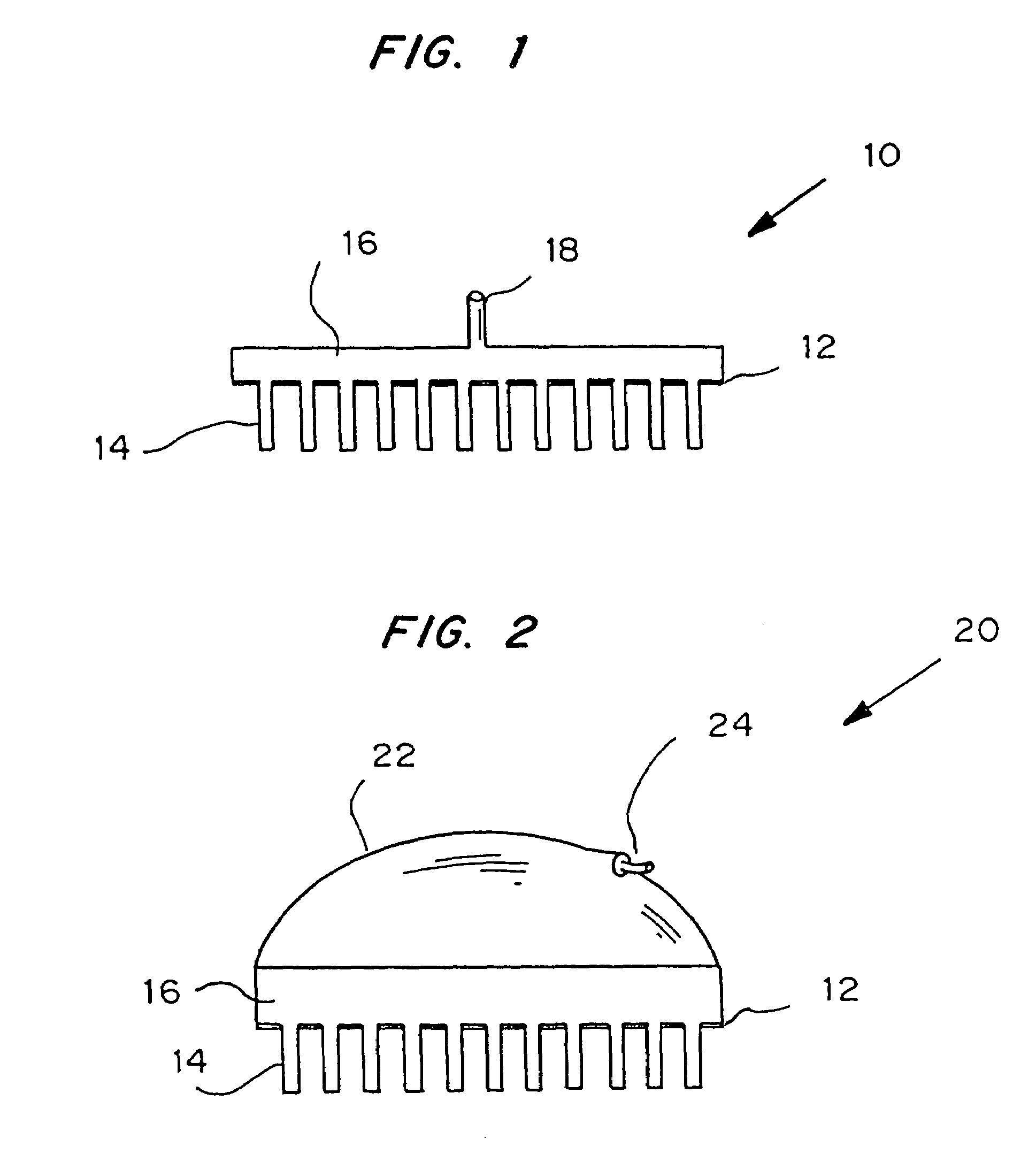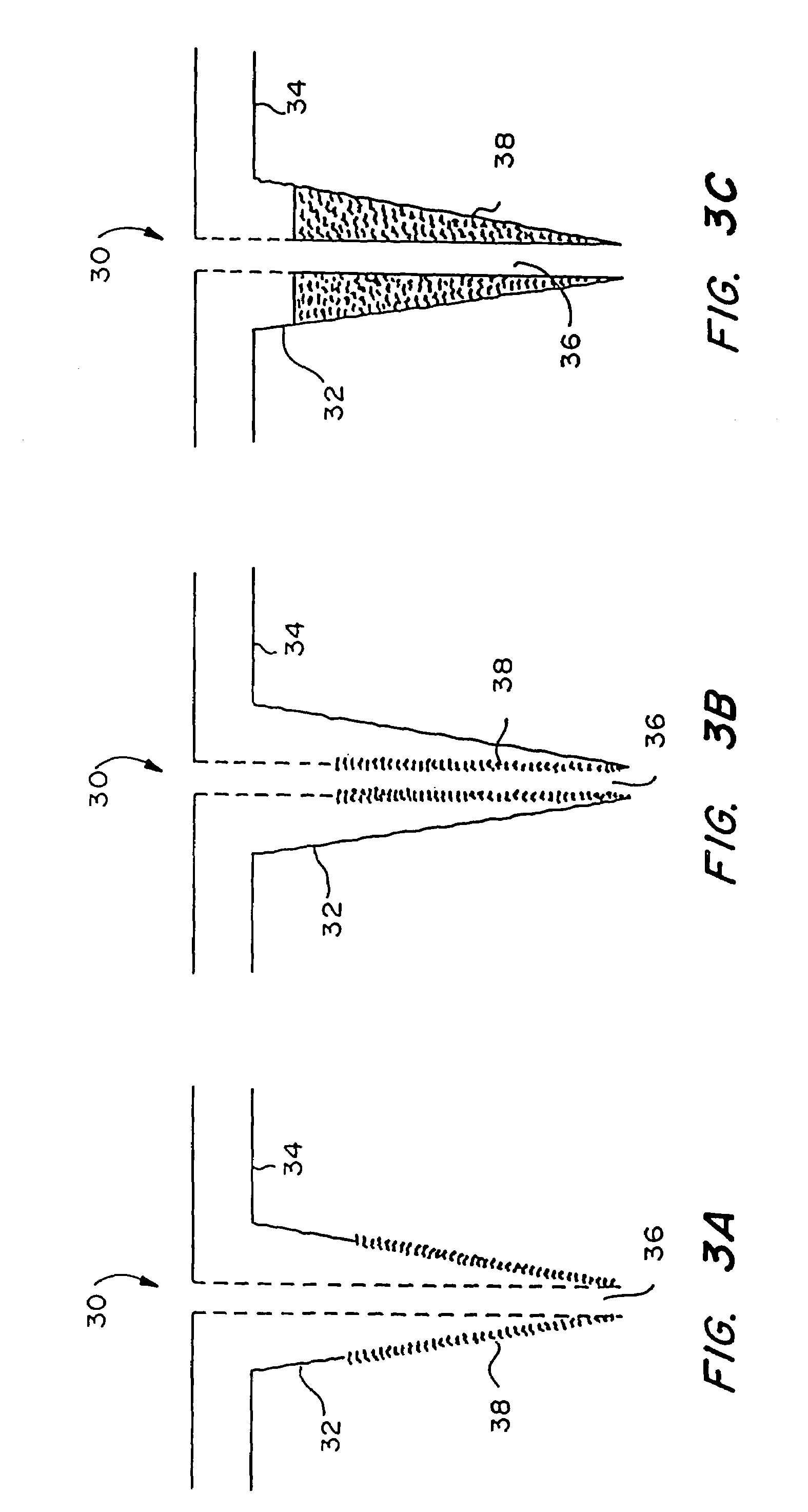Microneedle device for extraction and sensing of bodily fluids
a micro-needle and bodily fluid technology, applied in the field of micro-needle devices for the extraction and sensing of biological fluids, can solve the problems of increasing the risk of disease transmission, inconvenient, expensive, undesirable, inconvenient and expensive, etc., and achieves painless and convenient manner, minimal or no damage, pain or irritation to the tissue, and minimal or no damage
- Summary
- Abstract
- Description
- Claims
- Application Information
AI Technical Summary
Benefits of technology
Problems solved by technology
Method used
Image
Examples
example 1
Transport of Molecules Through Microneedles Inserted into Skin
[0144]Studies were performed to demonstrate transport of molecules using either solid silicon microneedles or using hollow silicon microneedles. Transport was measured across human cadaver epidermis in vitro using Franz diffusion chambers at 37° C. using methods described in Henry, et al., “Microfabricated microneedles: A novel method to increase transdermal drug delivery”J. Pharm. Sci. 87:922-25 (1998).
[0145]Removal of calcein was measured. Removal refers to the ability to transport calcein from the viable epidermis side of the epidermis to the stratum corneum side. This is the direction of transport associated with removing from the body compounds found in the body, such as glucose. Other compounds were tested for delivery only.
[0146]In all cases shown in Table 1, transport of these compounds across skin occurred at levels below our detection limit when no needles were inserted into the skin. When solid microneedles wer...
example 2
Flow of Water Through Hollow Microneedles
[0148]To demonstrate that fluid can be forced through hollow microneedles at meaningful rates, the flow rate of water through a microneedle array was measures as a function of pressure. The array used contained 100 hollow silicon microneedles having an inner diameter of 50 μm and an outer diameter of 80 μm. The results, which are shown in Table 2, demonstrate that significant flow rates of water through microneedles can be achieved at modest pressures. The measured flow rates are comparable to flow rates through hypodermic needles attached to syringes.
[0149]
TABLE 2Flow Rate of Water Through Hollow Silicon MicroneedlesAs a Function of Applied PressurePressure (psi)Flow rate (ml / min)1.0161.5242.0312.5383.045
example 3
Fabrication of Solid Silicon Microneedles
[0150]A chromium masking material was deposited onto silicon wafers and patterned into dots having a diameter approximately equal to the base of the desired microneedles. The wafers were then loaded into a reactive ion etcher and subjected to a carefully controlled plasma based on fluorine / oxygen chemistries to etch very deep, high aspect ratio valleys into the silicon. Those regions protected by the metal mask remain and form the microneedles.
[0151]-oriented, prime grade, 450-550 μm thick, 10-15 Ω-cm silicon wafers (Nova Electronic Materials Inc., Richardson, Tex.) were used as the starting material. The wafers were cleaned in a solution of 5 parts by volume deionized water, 1 part 30% hydrogen peroxide, and 1 part 30% ammonium hydroxide (J. T. Baker, Phillipsburg, N.J.) at approximately 80° C. for 15 minutes, and then dried in an oven (Blue M Electric, Watertown, Wis.) at 150° C. for 10 minutes. Approximately 1000 Å of chromium (Mat-Vac Tec...
PUM
 Login to View More
Login to View More Abstract
Description
Claims
Application Information
 Login to View More
Login to View More - R&D
- Intellectual Property
- Life Sciences
- Materials
- Tech Scout
- Unparalleled Data Quality
- Higher Quality Content
- 60% Fewer Hallucinations
Browse by: Latest US Patents, China's latest patents, Technical Efficacy Thesaurus, Application Domain, Technology Topic, Popular Technical Reports.
© 2025 PatSnap. All rights reserved.Legal|Privacy policy|Modern Slavery Act Transparency Statement|Sitemap|About US| Contact US: help@patsnap.com



